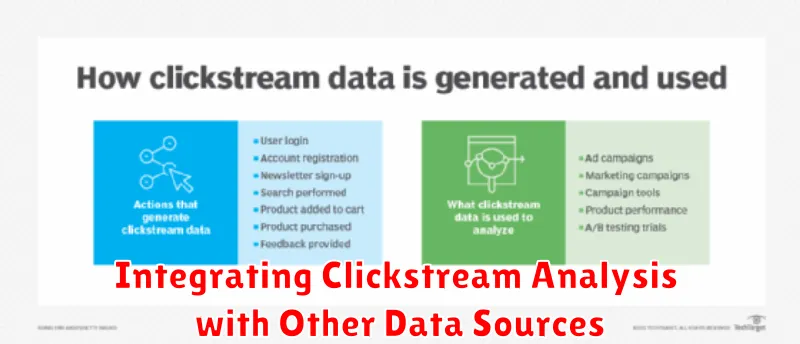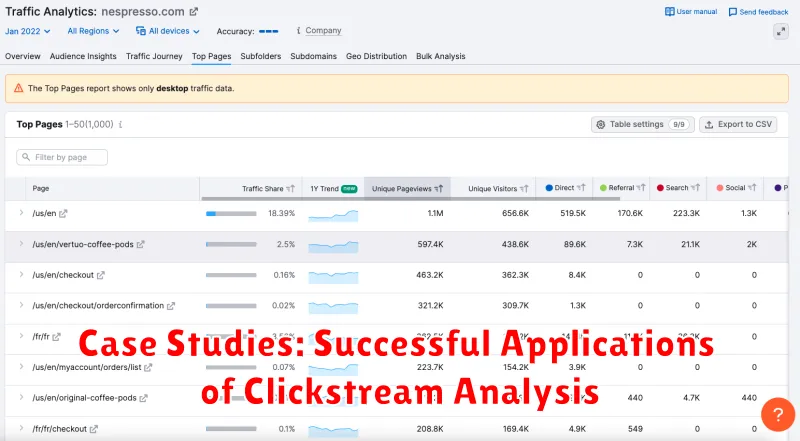In today’s competitive e-commerce landscape, understanding customer behavior is paramount to success. Clickstream analysis offers online retailers a powerful tool to unlock valuable customer insights. By meticulously examining the digital footprints customers leave behind as they navigate online stores, retailers can gain a granular understanding of their preferences, pain points, and purchasing patterns. This guide provides a comprehensive overview of clickstream analysis, detailing its importance for online retailers and how it can be leveraged to drive sales, improve customer satisfaction, and optimize online strategies. Harnessing the power of clickstream data can be transformative, providing the knowledge needed to personalize the customer journey, refine marketing campaigns, and ultimately, boost business performance.
This article will delve into the various methods of collecting and analyzing clickstream data, exploring the insights that can be extracted, and highlighting practical applications for online retailers. From understanding website navigation patterns and product discovery processes to identifying areas of friction and optimizing conversion rates, clickstream analysis offers a wealth of opportunities for improvement. By understanding how customers interact with their online stores, retailers can make data-driven decisions to create a more seamless and engaging shopping experience. This guide will equip you with the knowledge and tools to effectively implement clickstream analysis and unlock the full potential of your customer data, leading to a significant competitive advantage in the dynamic world of online retail.
What is Clickstream Analysis and Why is it Important?
Clickstream analysis is the process of collecting, analyzing, and reporting aggregate data about which pages a website visitor visits, and in what order. It provides valuable insights into user behavior on a website. Think of it as following the “clicks” of your customers as they navigate your online store.
This data is essential for online retailers because it reveals how customers interact with their website, products, and marketing campaigns. By understanding these patterns, businesses can optimize their online presence to improve customer experience, increase sales, and boost conversions.
Analyzing clickstream data allows businesses to understand which products are viewed most often, which paths customers take to complete a purchase, and where they drop off in the buying process. This information is crucial for making data-driven decisions related to website design, product placement, and marketing strategies. Ultimately, clickstream analysis provides the knowledge needed to create a more engaging and profitable online experience for customers.
How Clickstream Analysis Works in E-Commerce
Clickstream analysis in e-commerce involves collecting and analyzing data about user interactions on a website or app. This data is captured at various touchpoints throughout the customer journey.
The process begins with data collection. Various technologies, like web server logs, JavaScript tagging, and cookies, track user actions such as page views, product clicks, add-to-cart events, and purchases. This raw data is then consolidated and stored in a central repository, often a data warehouse or data lake.
Next, the data processing stage cleans, transforms, and prepares the data for analysis. This might involve filtering irrelevant information, handling missing values, and converting data into a usable format.
Finally, data analysis techniques are applied. These can range from simple aggregations and visualizations to more advanced methods like segmentation, cohort analysis, and predictive modeling. This analysis reveals patterns, trends, and insights about customer behavior.
Key Metrics in Clickstream Analysis
Clickstream analysis relies on several key metrics to provide valuable insights into customer behavior. Understanding these metrics is crucial for effective interpretation of the data.
Website Traffic Metrics
Number of Visits: Tracks the total number of visits to your website. Unique Visitors: Counts the number of individual users visiting your site, providing a clearer picture of your audience reach. Bounce Rate: Represents the percentage of visitors who leave after viewing only one page, indicating potential issues with content relevance or user experience. Exit Rate: Shows the percentage of visitors who leave your site from a specific page, highlighting potential pain points in the customer journey.
Customer Behavior Metrics
Click-Through Rate (CTR): Measures the percentage of users who click on a specific link or call to action, reflecting the effectiveness of your marketing efforts. Conversion Rate: Indicates the percentage of visitors who complete a desired action, such as making a purchase or signing up for a newsletter, crucial for assessing campaign success. Average Order Value (AOV): Calculates the average amount spent per order, useful for understanding customer spending habits. Time on Site: Tracks the duration visitors spend on your website, suggesting levels of engagement with your content. Pages per Visit: Shows the average number of pages viewed per visit, indicating user interest and navigation patterns.
Benefits of Using Clickstream Data for Online Retailers
Leveraging clickstream data offers online retailers a wealth of advantages, enabling data-driven decisions to optimize their online stores and marketing strategies for increased profitability. Here are some key benefits:
Enhanced Customer Understanding
Clickstream analysis provides granular insights into customer behavior, revealing their preferences, browsing patterns, and purchase journeys. This deepened understanding enables retailers to personalize the customer experience, offering targeted product recommendations and promotions.
Improved Website Optimization
By analyzing clickstream data, retailers can identify pain points in the customer journey, such as high bounce rates on specific pages or abandoned shopping carts. This allows for strategic website improvements, optimizing navigation, product placement, and checkout processes to enhance user experience and conversion rates.
Targeted Marketing Campaigns
Clickstream data empowers retailers to create highly targeted marketing campaigns. By understanding customer segments and their interests, marketers can deliver personalized messages and promotions, maximizing engagement and return on investment.
Inventory Management Optimization
Analyzing product views, purchases, and abandoned cart items provides valuable insights into product demand and customer preferences. This information enables retailers to optimize inventory levels, reducing storage costs and maximizing sales opportunities.
Clickstream Analysis Tools and Technologies
Various tools and technologies facilitate clickstream analysis, offering diverse functionalities and capabilities. Selecting the right tool depends on the specific needs and resources of the online retailer.
Web Analytics Platforms: Platforms like Google Analytics and Adobe Analytics are fundamental for collecting and analyzing website traffic data. They provide insights into user behavior, traffic sources, and conversion rates. These tools often form the foundation upon which further clickstream analysis is built.
Session Replay Tools: These tools allow businesses to replay individual user sessions, visually observing their interactions on the website. This provides a granular understanding of customer journeys and helps identify usability issues or areas of friction.
Heatmapping and Scroll Tracking Tools: Visualizing user behavior through heatmaps and scroll maps provides insights into where customers click, move their mouse, and how far they scroll down a page. This data can inform website design and content optimization strategies.
A/B Testing and Personalization Platforms: Integrating clickstream data with A/B testing platforms enables retailers to experiment with different website versions and personalize content based on user behavior. This allows for data-driven optimization of the user experience.
Big Data Platforms and Machine Learning: For large datasets, big data technologies like Hadoop and Spark, combined with machine learning algorithms, can be employed to uncover deeper patterns and predict future customer behavior.
Best Practices for Effective Clickstream Analysis
Implementing clickstream analysis effectively requires careful planning and execution. Data quality is paramount. Ensure accurate data collection by minimizing errors and addressing any gaps in tracking. Clearly defined objectives are crucial. Establish specific goals for your analysis, whether it’s improving conversion rates, personalizing product recommendations, or optimizing website navigation.
Segmentation is key to unlocking meaningful insights. Group customers based on shared behaviors and characteristics to understand their unique journeys. Don’t overlook the importance of data privacy. Adhere to regulations and be transparent with customers about how their data is being used. Finally, continuous monitoring and optimization are essential for success. Regularly review your analysis process, adjust strategies based on findings, and stay updated with the latest clickstream analysis techniques.
Integrating Clickstream Analysis with Other Data Sources

While clickstream data provides valuable insights into online behavior, integrating it with other data sources enriches these insights and paints a more holistic picture of the customer. Combining clickstream data with other sources allows for a deeper understanding of customer motivations, preferences, and the overall customer journey.
CRM data, for instance, can be linked with clickstream data to understand how online behavior correlates with offline purchases or customer service interactions. This integration allows businesses to personalize offers and target specific customer segments more effectively.
Marketing automation platforms can leverage integrated data to trigger personalized email campaigns based on website activity. For example, if a customer abandons their cart, an automated email reminding them of their items and offering a discount can be sent.
Product data can be combined with clickstream data to understand which products are viewed most often, which products are frequently purchased together, and which product pages lead to higher conversion rates. This data is crucial for product recommendations and optimizing product placement on the website.
Finally, integrating with social media analytics can provide context around customer sentiment and brand perception. This allows businesses to understand how their social media presence influences website traffic and purchasing decisions.
Using Clickstream Data to Improve Customer Experience
Clickstream data provides invaluable insights that can be directly applied to enhance the customer experience. By understanding how users navigate your website, you can identify pain points and optimize their journey.
Personalized Recommendations: Analyzing clickstream data allows you to understand individual customer preferences and offer tailored product recommendations. This personalization increases the likelihood of conversion and fosters customer loyalty.
Website Optimization: Identify bottlenecks and drop-off points in the customer journey by examining click patterns. Streamlining navigation, simplifying checkout processes, and improving site search functionality based on this data can significantly enhance usability.
Targeted Content Delivery: Presenting relevant content at the right time is crucial for engagement. Clickstream analysis helps determine which content resonates with specific user segments, enabling you to deliver targeted promotions, offers, and information that aligns with their interests.
A/B Testing and Experimentation: Utilize clickstream data to measure the effectiveness of different website versions or marketing campaigns. By analyzing user behavior on different variations, you can identify the most effective strategies for driving conversions and improving engagement.
Case Studies: Successful Applications of Clickstream Analysis

Examining real-world examples illustrates the power of clickstream analysis. One major e-commerce platform used clickstream data to analyze shopping cart abandonment. By identifying the point in the checkout process where users most frequently dropped off, they were able to streamline the experience. This resulted in a significant increase in completed purchases and a measurable boost in revenue.
Another case involves a fashion retailer leveraging clickstream data to personalize product recommendations. By tracking browsing history and purchase patterns, they could offer tailored suggestions to individual customers. This personalized approach led to higher click-through rates on recommendations and a demonstrable lift in sales conversions.
A subscription-based service provider utilized clickstream analysis to identify struggling users. By analyzing user interactions within their platform, they pinpointed areas where users experienced difficulty navigating or utilizing key features. This allowed them to proactively offer support and improve the onboarding experience, leading to increased user retention and satisfaction.
Overcoming Challenges in Clickstream Analysis
While clickstream analysis offers valuable insights, several challenges can hinder its effectiveness. Data volume can be overwhelming, requiring robust infrastructure and efficient processing capabilities. Data quality is another concern, as incomplete or inaccurate data can lead to misleading conclusions. Ensuring data accuracy and completeness is crucial for reliable analysis.
Data privacy is a paramount concern. Retailers must adhere to regulations and respect user privacy when collecting and analyzing clickstream data. Anonymization and aggregation techniques can help mitigate privacy risks while still providing valuable insights.
Analysis complexity can also pose a challenge. Interpreting raw clickstream data requires expertise in data analysis and statistical modeling. Choosing the right analytical tools and techniques is essential for extracting meaningful insights.
Data integration from various sources can be complex. Combining clickstream data with other customer data, such as demographics and purchase history, can enrich analysis but requires careful planning and execution.

